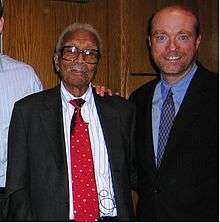Sweatt v. Painter
| Sweatt v. Painter, et al. | |||||||
|---|---|---|---|---|---|---|---|
|
| |||||||
| Argued April 4, 1950 Decided June 5, 1950 | |||||||
| Full case name | Heman Marion Sweatt v. Theophilus Shickel Painter | ||||||
| Citations |
70 S. Ct. 848; 94 L. Ed. 1114; 1950 U.S. LEXIS 1809 | ||||||
| Prior history | Cert. to the Supreme Court of Texas | ||||||
| Holding | |||||||
| The Equal Protection Clause of the Fourteenth Amendment requires that petitioner be admitted to the University of Texas Law School. | |||||||
| Court membership | |||||||
| |||||||
| Case opinions | |||||||
| Majority | Vinson, joined by unanimous | ||||||
Sweatt v. Painter, 339 U.S. 629 (1950), was a U.S. Supreme Court case that successfully challenged the "separate but equal" doctrine of racial segregation established by the 1896 case Plessy v. Ferguson. The case was influential in the landmark case of Brown v. Board of Education four years later.
The case involved a black man, Heman Marion Sweatt, who was refused admission to the School of Law of the University of Texas, whose president was Theophilus Painter, on the grounds that the Texas State Constitution prohibited integrated education. At the time, no law school in Texas would admit black or "Negro" students.
Procedural history
The state district court in Travis County, instead of granting the plaintiff a right of mandamus, continued the case for six months. This allowed the state time to create a law school only for black students, which it established in Houston, Texas, rather than in Austin. The 'separate' law school and the college became the Thurgood Marshall School of Law at Texas Southern University (known then as "Texas State University for Negroes").
The trial court decision was affirmed by the Court of Civil Appeals and the Texas Supreme Court denied writ of error on further appeal. Sweatt and the NAACP next went to the federal courts, and the case ultimately reached the U.S. Supreme Court. Robert L. Carter and Thurgood Marshall presented Sweatt's case.
U.S. Supreme Court
The Supreme Court reversed the lower court decision, saying that the separate school failed to qualify, both because of quantitative differences in facilities and intangible factors, such as its isolation from most of the future lawyers with whom its graduates would interact. The court held that, when considering graduate education, intangibles must be considered as part of "substantive equality." The documentation of the court's decision includes the following differences identified between white and black facilities:
- the University of Texas Law School had 16 full-time and 3 part-time professors, while the black law school had 5 full-time professors.
- the University of Texas Law School had 850 students and a law library of 65,000 volumes, while the black law school had 23 students and a library of 16,500 volumes.
- the University of Texas Law School had moot court facilities, an Order of the Coif affiliation, and numerous graduates involved in public and private law practice, while the black law school had only one practice court facility and only one graduate admitted to the Texas Bar.
Legacy
On June 14, 2005, the Travis County Commissioners voted to rename the courthouse as The Heman Marion Sweatt Travis County Courthouse in honor of Sweatt's endeavor and victory.

See also
- List of United States Supreme Court cases, volume 339
- Sipuel v. Board of Regents of Univ. of Okla. - 332 U.S. 631 (1948)
- McLaurin v. Oklahoma State Regents - 339 U.S. 637 (1950)
References
State of Texas vs. NAACP case records, 1911-1961 1945-1961. Description: photocopied documents. 2 microfilm reels. Summary: Records document the 1956-1957 lawsuit that, in effect, outlawed the NAACP in Texas until the 1960s and also reflects the progress of the civil rights movement from the late 1940s to the 1960s.
Byron and Rannie Cook Papers, 1944-1962, Center for American History, University of Texas at Austin. Summary: Correspondence, newspapers, clippings, broadsides, ephemera, speeches, programs, notes, platforms, annual reports, printed material, magazines and artifacts relate to the Cook's involvement with the National Alliance of Postal Workers (Houston Chapter), the NAACP in Houston, service at the U.S. Post Office at Houston, the Progressive Party, the Henry Wallace presidential campaign, Leonard Sweatt, Heman Sweatt, John Butler and with unions.
The items above and other important material can be found in the University of Texas Library system at this link: http://www.lib.utexas.edu/about/librarymap/cah.html
Further reading
- Lavergne, Gary M. (2010). Before Brown: Heman Marion Sweatt, Thurgood Marshall, and the Long Road to Justice. Austin, Texas: University of Texas Press. ISBN 9780292778023.
External links
![]() Works related to Sweatt v. Painter at Wikisource
Works related to Sweatt v. Painter at Wikisource
- Full text of the decision courtesy of Findlaw.com
- Sweatt v. Painter archive
- Full text at law.cornell.edu

